Having a saxophone fingering chart is essential. An accurate saxophone fingering chart is an invaluable tool for every beginning saxophone student. True, it can be fun, and even beneficial, to try and figure out some of the fingerings yourself. Figuring out how the saxophone works on your own, self-directed study, can be a valuable process, one that can further ingrain the fundamentals as well as solidify the learning experience. Many saxophone fingerings are, in fact, fairly intuitive. But some are not. In some cases, the fingering that is the most intuitive isn’t even the best choice. Ultimately, in order to ensure accuracy and to avoid potential frustration, it’s a good idea to have a reliable reference on hand.
How to Interpret the Saxophone Fingering Chart
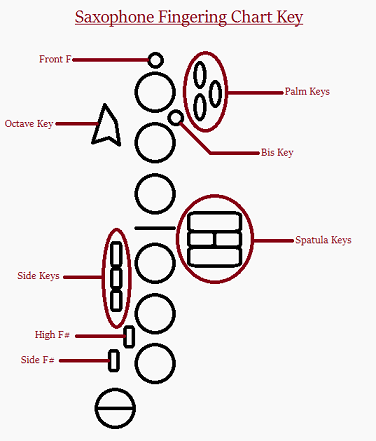
There are numerous saxophone fingering charts out there. If you search the internet, you’ll find countless examples. In addition to those on the internet, there are also several saxophone fingering charts available in various saxophone method books. However, many of the saxophone fingering charts out there come with little or no explanation on how to read and interpret them.
Many notes on the saxophone have only one possible fingering. When there’s more than one fingering listed, the saxophone fingering chart I’ve provided has each note’s fingerings listed in order of preference; in order of which fingering is most commonly utilized.
Something that many saxophone fingering charts fail to address is the names that key groupings are regularly referred to by. Groups of keys have names. I’ve provided a saxophone fingering chart key that labels the key groupings. This will give you an idea of what someone is referring to when they talk about the “palm keys” or the “spatula keys” or the “side keys”. In addition, certain individual keys have names they’re referred to by as well. To distinguish alternate fingerings, certain keys are referred to as the “bis key” or the “front F key”.
Alternate Fingerings
Most notes on the saxophone have only one viable fingering. As stated above, the fingerings on the provided saxophone fingering chart are, for the most part, in order of preference. Where there is more than one fingering listed, the fingerings are listed in order of which is utilized more often. For the most part, when there is a second fingering listed, it is a fingering that’s used for trills or for fast chromatic passages. Since most fingering charts come with little or no explanation, I’ve decided to provide a brief explanation of scenarios when you would use one of the alternate fingerings in place of the main fingering.
- Bb/A# Fingerings: I made a point above of stating that the fingerings on the provided saxophone fingering chart are “for the most part” in order of utilization. Bb/A# is one of two exceptions to this rule. The two fingerings for Bb/A# are used pretty much equally; 50/50. The side key is useful when playing in a key with A#, such as F# or B, where you’ll be going from A# to B a lot. The bis key is useful when playing in keys with Bb, such as F and Bb, where you won’t really be playing B. This is, of course, a huge oversimplification, but a good rule of thumb. There are two more fingerings for Bb/A# that I’ve intentionally left off of my fingering chart. The “1+1” fingering and the “1+2” fingering are included on many other fingering charts, but I don’t think they’re good for beginners to use. In fact, I don’t really think they’re good for anyone to use. I use them 0% of the time, and most people I’ve met or played with do the same. Bb/A# with these fingerings have little resonance and poor intonation on most horns. When you become a more advanced player, you can decide if they work well for you, but for now, it’s probably best to use the main two fingerings.
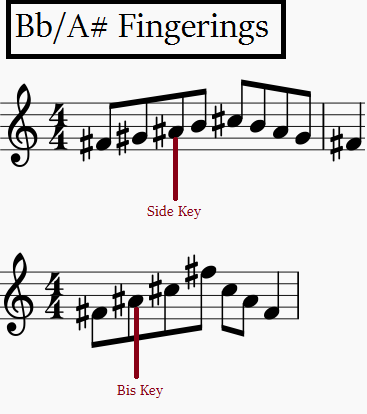
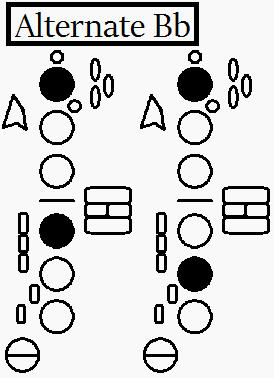
- Side Keys (Side C and Side F#/Gb): In addition to the side Bb/A# key, there are also side keys for C and F#/Gb. The side C key isn’t the most resonant or in tune. It doesn’t sound nearly as good as the main C fingering, but definitely has a purpose. It’s useful when playing a B trill, when playing a chromatic scale, or when playing certain fast passages like the example provided. The side F#/Gb key is similar, although it’s used a little more often. Its resonance and intonation is actually pretty good, at least on my horns. It’s useful when playing an F-to-F# trill, a chromatic scale, or fast passages like the example provided. It’s also useful when playing an F# major scale or Db major scale, or any scale that has F to F#/Gb in it.
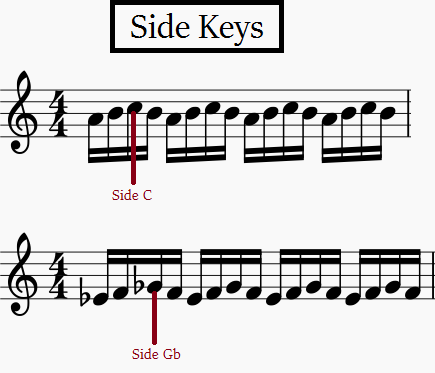
- G# Fingerings: One of the spatula keys is the “G# key”, but it’s helpful to know that any spatula key can be used to play G#. Knowing this can make certain passages a little easier or a little more fluid. If you need to play low B to G#, you can use the B spatula key to finger G#, requiring less movement. In keys with both G# and C# (such as A, E, B, F#, Db, Ab), I usually keep my pinky on the C# spatula key the whole time. I probably use the C# spatula key to finger G# just as often as I use the G# key, if not more often. It’s also good to know that you can leave the G# key, or any spatula keys, down the whole time you’re playing. This makes certain passages easier. I often joke that this is the saxophone’s improvement over the clarinet and flute. On those instruments, you cannot leave this fingering down when playing other notes.
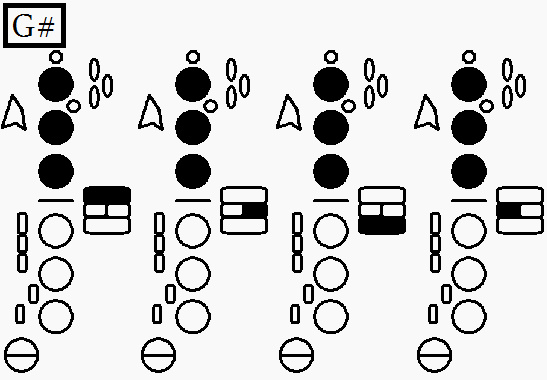
- High F Fingerings: High F is the other “for the most part” exception. The two high F fingerings are, like the Bb/A# fingerings, used pretty equally, depending on the situation. The main F fingering sounds a bit better than the front F fingering, but doesn’t work as well in certain situations. The front F fingering is useful when playing an F arpeggio. It also becomes very useful when playing in the altissimo register. I think of it as the “gateway” into the altissimo register. But, that’s more of an advanced concept. Similarly, there is a fingering for high E, which is this fingering plus your left hand ring finger.
The provided saxophone fingering chart is in no way an exhaustive resource. Even the alternate and extra fingerings just explained don’t provide a full list of possible saxophone fingerings. The fingerings on the provided saxophone fingering chart will most likely be the fingerings you use 90-100% of the time. However, with time and experience, you may figure out some more possible alternate fingerings that work well for you.
Most other fingerings you will figure out will just be slight adjustments to the fingerings on the provided chart. Adding certain keys to the main basic fingerings can slightly change intonation, timbre, or resonance. The high F# on my tenor saxophone runs a little flat, so I add the Bb spatula key whenever I can to bring it in tune. You may find that certain notes on your particular horn benefit from adding other keys in some situations. Other fingerings provide enough of a timbre difference that it sounds as though a note was reattached. This is an effect you can use, a la Brecker, with certain notes, such as middle Bb, B, C, C#, high G, etc.
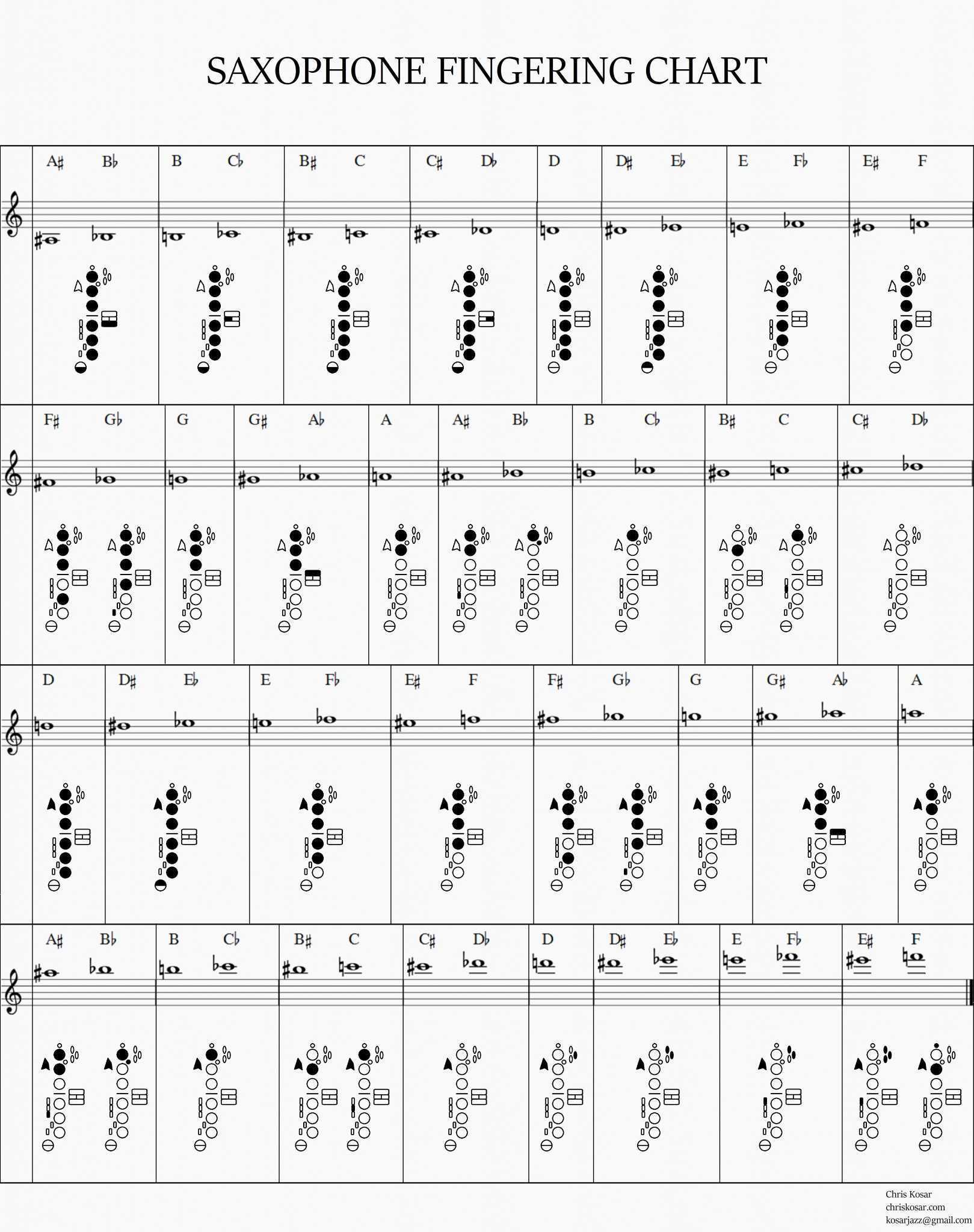
Conclusion
It is beneficial to have a good saxophone fingering chart, especially for beginning saxophone students. The chart I’ve provided is intuitive, accurate, concise, and precise, but is in no way exhaustive. Over time, you would develop a feel for what is comfortable for you. Just remember, what is comfortable at the moment is not always what’s ultimately best. It’s easy to call a bad habit the easiest option. In other words, a new fingering is naturally more difficult than what you’ve become used to, but getting past the initial learning curve will make the new fingering ultimately more efficient. You should also keep in mind that the information provided in this article is my opinion. From my experience, I also believe that it’s the most popular opinion on the subject, but it’s not the only one. Some saxophone players use the “1+1” fingering as their main Bb fingering. Most people I’ve talked to about it don’t. I also know that the “1+1” fingering sounds absolutely terrible on my particular horns. Maybe it sounds good on your horn. These are things that will develop over time. This saxophone fingering chart is simply a good resource to have on hand when you are learning play the saxophone.



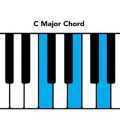
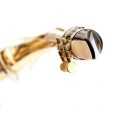
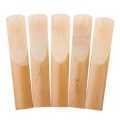
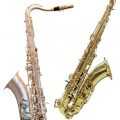
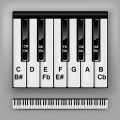
Thank you for this great Fingering chart. I'm a newbie in playing saxophone, it's very simple and helpful. Leo. Indonesia
Thank you for this valuable information on the saxophone fingering. I just started playing the alto sax two months ago and I have a method book that illustrates the fingering, but you info is more extensive.